A-7huge magnetic spring, the gradual unwinding of which, occurring in stages some time afterthe explosion, required the Earth's crust to move.There is a significant number of botanic, climatic, archaeological, and historicfindings already accumulated which perfectly fit the above hypothesis, and whichsimultaneously have no other interpretation. However, independent of all the factsestablished so-far, conclusive verification of the correctness of the author's hypothesis canalso be completed. This requires reviewing written historic records concerning the period ofabout 200 years following the Tapanui explosion. Amongst many others, such recordsshould contain the description of numerous "unpleasant" consequences resulting from apossible movement of the Earth's crust. The most distinct of these would be powerful"tsunami" waves that should sweep all coasts positioned towards the direction of the motion(e.g. the northern coasts of Europe & Africa and the southern coasts of New Zealand &Japan). Some records of floods caused by such tsunami could be present in historicchronicles. In fact there are indications of their existence. For example the book byHermann Flohn and Roberto Fantechin (Commission of the European Communities), "TheClimate of Europe: past, present and future" (D. Reidel Publishing Company, Holland,1984, ISBN 90-277-1745-1, page 38) contains the following statement, quote: "In Europe,the first signs of serious climatic disturbances came with a number of great wind-stormsand sea floods over the low-lying coasts, for instance around the North Sea, in thethirteenth century. The reported drowning of 100,000 to 400,000 people in some of theseincidents places them among the worst ever recorded weather disasters." (This quote refersto the diocese of Schleswig.) It is also worth noting that near Bluff in New Zealand the firstwhite settlers found decaying tree trunks whose orderly "inland" (and northward) directingcould indicate their destruction by such sea floods.If by any chance the correctness of this hypothesis is conclusively confirmed, theTapanui explosion would become the most important event in the recent history of ourplanet. Its implications would reach not only disciplines directly involved (e.g. history orgeography), but also to these seemingly non-connected such as politics, peace movement,nuclear experiments, and many more. This is because the Tapanui event revealed thevalue of the "critical explosive charge" which suffices to tilt the Earth's crust. This valueseems to be "only" about 70 megaton of TNT, i.e. the explosive power which can presentlybe released even in local nuclear conflict. Therefore, the Tapanui warns people about theconsequences of such a nuclear war.The evidence collected about the Tapanui explosion represents a number of totallydifferent classes of facts, such as legends, naming, historic records from eye witnesses,environmental changes, post-explosive material remains, global climatic changes. However,all this huge evidential material displays striking cause-effect coherence. Also, a significantproportion of it allows for independent dating, the results of which always point to the sameyear, 1178. Furthermore, there are multi-level similarities between the Tapanui explosionand the Tunguska blast. Together all this provides sufficient premise to conclude that in theyear 1178 there was a powerful explosion in New Zealand, very similar to that of Tunguskain 1908.When Leonid Aleksiejewicz KULIG, the investigator of the Tunguska blast site,presented in 1925 the material evidence which he accumulated about this powerful Siberianexplosion, his discoveries were received with scepticism and opposition. Over 60 yearslater exactly the same attitude was repeated in New Zealand for the Tapanui Crater. Thetreatise presenting evidence that in 1178 a huge spaceship exploded there was greeted asscientific heresy. The typical stand of New Zealand scholars regarding the author'sevidence identified so-far has been totally rejective and counter-arguing that: the TapanuiCrater is only a large landslip, all material evidence for a powerful explosion in this place isonly a series of chances, internal cause-effect coherence of subsequent evidence is alsocoincidental, the similarities in dates of origin of this material evidence must surely resultfrom imperfections of the present dating methodologies, historic records and climatic
A-8changes have no connection with Tapanui, meaningful content of Maori names must be anerror in their translation, and descriptive legends on the Fires of Tamaatea are onlyproducts of the imagination. This is a very strange stand, because the remains of theTapanui explosion are so omnipresent in the South Island of New Zealand that their denialand ignoring requires more energy than their actual investigating. Unfortunately, officialrecognition of the evidence accumulated by the author would also mean formal admittancethat in ancient times UFOs have exploded above New Zealand - it seems that for manypeople acknowledging this would crush their belief system.Ignoring of the Tapanui explosion is a significant loss not only to New Zealand butalso to the whole planet. By doing this, the following opportunities are dismissed. Firstly,New Zealand is resigning from one of its tourist attractions, located in an easily accessiblearea, which visitors to this country would probably be interested to see (not mentioningTapanui "Crop Circles" - see Figure G8, similar to those currently boosting the Englishtourist industry). Secondly, New Zealand scholars are ignoring the main cause of manymysteries of their country, such as the rapid extinction of the Moa bird, a historic lack offorests in the central and eastern parts of the South Island, the origin of scorched treesscattered around this area, surface gold deposits in Central Otago, "china stones", andmany more. Thirdly, only two such explosions occurring in historic times have so-far beendetected. Therefore their locations have high scientific value. Fourthly, the Tapanui Crater,as with the Tunguska blast site, is a natural laboratory of immense importance, in whichlong-term consequences of magnetic exposure can be monitored. Finally, the power of thisexplosion permanently changed the Earth's climate (most probably through tilting theplanet's crust by 7-degrees) similarly this can be caused by a possible nuclear war.Therefore, the Tapanui explosion could be utilized for studying and political illustration ofthe destructive effects of nuclear conflict.
- Page 1 and 2: Proof Copy ([5e/3] reformatted to P
- Page 3 and 4: 3G-83 G. Evidence certifying that M
- Page 5 and 6: 5Notes:(1) Before this monograph wa
- Page 7 and 8: A-2or disk"). The information which
- Page 9 and 10: A-4immune deficiency, thus it is qu
- Page 11: A-6edition, 1986) even tries to arg
- Page 15 and 16: A-10Fig. A2. The curved slope in th
- Page 17 and 18: B-12inspired me to suspect that hum
- Page 19 and 20: B-14Earth by evil UFOnauts God trie
- Page 21 and 22: C-16#10. The spread, radiating from
- Page 23 and 24: C-18"Te Ura-a-Te Raki-Tamau", which
- Page 25 and 26: C-20item #2 that follows). Thus, in
- Page 27 and 28: C-22comparative data which reflects
- Page 29 and 30: C-24exploding fires, columns of fir
- Page 31 and 32: C-26banks of the Black Gully Creek,
- Page 33 and 34: C-28meditating, conducting healing
- Page 35 and 36: C-30deaths of people with symptoms
- Page 37 and 38: C-32(1) The Kawakawa volcano erupte
- Page 39 and 40: C-34The Tapanui Crater is the centr
- Page 41 and 42: C-36Fig. C2. The inner topography o
- Page 43 and 44: C-38(a)(d)(b)(c)(e)Fig. C4. Example
- Page 45 and 46: C-40Fig. C6. The illustration of si
- Page 47 and 48: C-42Fig. C8. The distribution of in
- Page 49 and 50: C-44Fig. C10. Two photographs of a
- Page 51 and 52: C-46Fig. C12. The location of near-
- Page 53 and 54: C-48Fig. C14. A magnetized metallic
- Page 55 and 56: D-50Chapter D:EVIDENCE THAT THE TAP
- Page 57 and 58: D-52including Mediterranean and Biz
- Page 59 and 60: D-54rapidly released by this explos
- Page 61 and 62: D-56experiments, and many more. Thi
- Page 63 and 64:
D-58that people were in medieval ti
- Page 65 and 66:
D-60then continually resonates in t
- Page 67 and 68:
D-62"tapanui.htm") are to be met, s
- Page 69 and 70:
D-64when such abnormalities of the
- Page 71 and 72:
E-66Chapter E.HYPOTHESES EXPLAINING
- Page 73 and 74:
E-68is directed towards the magneti
- Page 75 and 76:
F-70publication of this design and
- Page 77 and 78:
F-72can be built, each type taking
- Page 79 and 80:
F-74sites an explosive growth of mu
- Page 81 and 82:
F-76F4. Explosion sites of the Magn
- Page 83 and 84:
F-78- Deficiency of some sensitive
- Page 85 and 86:
F-80(a)…(b)…(c)Fig. F2. The des
- Page 87 and 88:
F-82Fig. F4. The explanation for a
- Page 89 and 90:
G-84The formal proof that "UFOs are
- Page 91 and 92:
G-86civilization(s) sending UFOs mu
- Page 93 and 94:
G-88the close proximity of the Tapa
- Page 95 and 96:
G-90(c)(d)Fig. G1. Two photographs
- Page 97 and 98:
G-92(a)(c)(b)(d)(e)Fig. G3. A spher
- Page 99 and 100:
G-94(a)(b)(c)(d)Fig. G5. Pulsating
- Page 101 and 102:
G-96(a)(b)(c)(d)(e)Fig. G7. Smooth,
- Page 103 and 104:
G-98(a)(b)(c)(d)Fig. G9. Photograph
- Page 105 and 106:
H-100#6. The Tapanui Crater is orie
- Page 107 and 108:
I-102Chapter I:MORAL ACCENTUATION O
- Page 109 and 110:
J-104explosion energy carrier would
- Page 111 and 112:
J-106detonation a number of appropr
- Page 113 and 114:
J-108resembled "china stones" from
- Page 115 and 116:
K-110Chapter K:AROUND 13 500 YEARS-
- Page 117 and 118:
K-112civilisation were prepared for
- Page 119 and 120:
L-114Chapter L:STILL ANOTHER UFO EX
- Page 121 and 122:
L-116Coincidentally, the author had
- Page 123 and 124:
M-118in section D3). This in turn h
- Page 125 and 126:
N-120Chapter N:TWELVE TRUTHS ABOUT
- Page 127 and 128:
N-122only factors which may cause t
- Page 129 and 130:
N-124ones who stand by truth and th
- Page 131 and 132:
O-126Chapter O:ACADEMIC ASPECTS OF
- Page 133 and 134:
O-128Galactic field, thus producing
- Page 135 and 136:
O-130specifically what was wrong wi
- Page 137 and 138:
O-132moral field causes that we acc
- Page 139 and 140:
O-134white glowing balls of playful
- Page 141 and 142:
O-136brought disgrace to that unive
- Page 143 and 144:
O-138the Polish language only, whic
- Page 145 and 146:
O-140occupation of Earth, and then
- Page 147 and 148:
O-142in a few years of time, when t
- Page 149 and 150:
O-144and both these matters were se
- Page 151 and 152:
O-146today. We need to realize this
- Page 153 and 154:
O-148Of course, the above history i
- Page 155 and 156:
O-150two kinds of resource publicat
- Page 157 and 158:
R-152Chapter R:AT THE END OF THIS M
- Page 159 and 160:
R-154forget that such paid scientis
- Page 161 and 162:
S-156Chapter S:REFERENCES COMPLEMEN
- Page 163 and 164:
S-158[7/2] Giordano D. and Pajak J.
- Page 165 and 166:
T-160Magnocraft exploded over New Z
- Page 167 and 168:
Z-162Appendix Z:Directions for gett
- Page 169:
Z-164Fig. Z1. The most educational


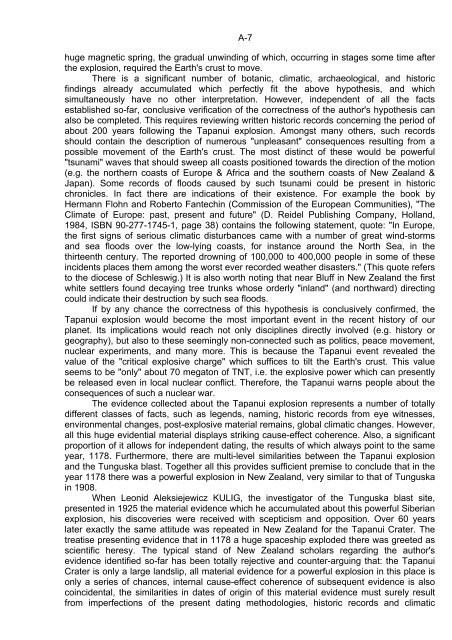
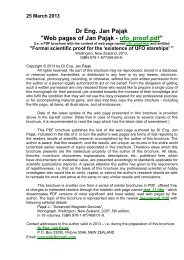


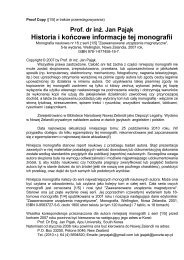
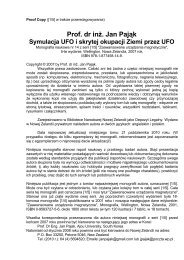
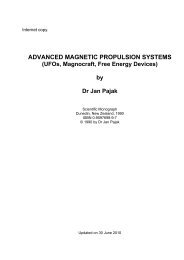
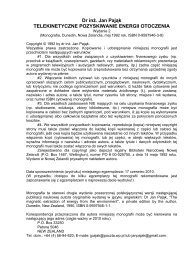
![[1/4p]: PDF - Totalizm](https://img.yumpu.com/45003232/1/184x260/1-4p-pdf-totalizm.jpg?quality=85)
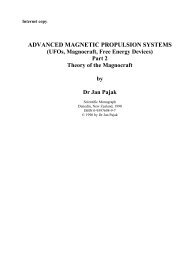
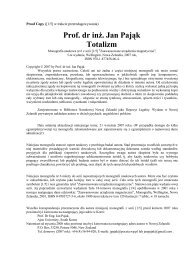
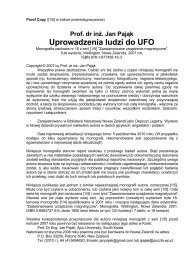
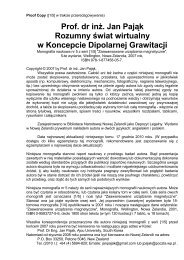
![[1/4p]: PDF - Totalizm](https://img.yumpu.com/39351336/1/184x260/1-4p-pdf-totalizm.jpg?quality=85)
